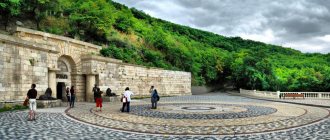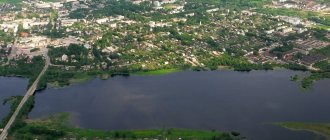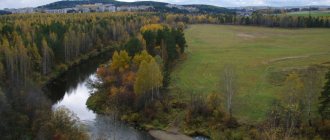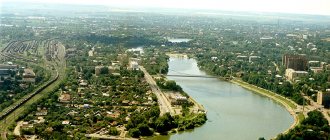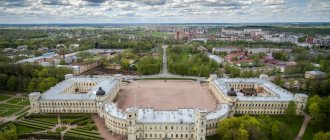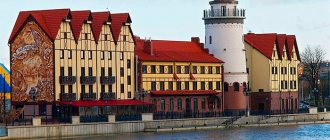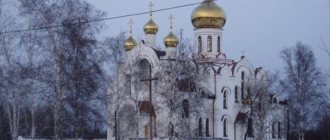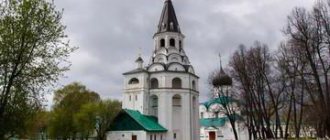Legends and facts
Cherepovets was officially founded by decree of Catherine II in 1777. But if you believe archaeological excavations, you can see that people lived in the city in ancient times. This is evidenced by the found stone tools, bone devices for sewing from skins, as well as the skull of a person who is approximately 6 thousand years old.
The more modern history of Cherepovets begins in the 14th century with the legend of the miraculous salvation of a Moscow merchant. They say that a merchant named Theodosius sailed along the Sheksna River with goods. Suddenly it suddenly got dark, and the boat ran aground.
It is unknown what would have happened to the merchant next if he had not started praying. After appealing to God, Theodosius saw a mountain on which a wonderful glow appeared. It illuminated the road and showed the merchant the further path. Immediately after this, the boat itself refloated and floated towards this glow.
A year later, the merchant returned to “God’s” place and founded a small chapel. Nowadays it is known as the Cherepovets Resurrection Monastery.
Newspaper "Rech" Issue dated August 27, 2021
Local historian Alexander Mokin, one of the administrators of the Cherepovets Nostalgia community on VKontakte and the author of a book about the history of our city, told Rech how he helped give names to new streets that appeared in the Pulovsky Forest area.
Streets Cherepovets
On June 15, the mayor issued a decree naming 18 new streets in the city. They are located in Zarechye, while these streets are not even on the map yet.
“On the territory of the Pulovsky Forest, people still received ownership of some of the plots,” says Alexander Mokin. — There is construction going on there and many streets have appeared, people need to be registered, addresses assigned. And the city architecture department suggested posting a post in the Cherepovets Nostalgia group with possible options for the names of these streets. The names are normal, but have no relation to our city: Zapovednaya, Ozernaya streets, and some of the streets were also proposed to be named after the regional centers of the region. I wrote a message to the chief architect Anton Anikin on the VKontakte network that I needed to come up with something more original. He completely agreed with me and asked me to write down my proposals.
Another Cherepovets resident, Nikolai Golovkin, also well known to city residents, joined the discussion with specialists from the architecture department: thanks to his efforts, we can monitor the movements of buses around the city in real time through a phone or computer.
Alexander Mokin proposed naming the new streets not in honor of the regional centers of the Vologda region - he believes that this would be more suitable for Vologda, as a regional center - but in honor of those cities that have a street named Cherepovetskaya.
“If we name streets after some settlements, then it is better to remember a good idea that was started in 2015, when in the Zasheksninsky district several streets were named after cities where there are streets named after Cherepovets. This is how Kemerovo, Novokuznetskaya, Lipetskaya, Donetskaya and Volgogradsky Boulevard streets appeared on the city map. There are only 15 cities in Russia where there is Cherepovetskaya Street. So far we have responded in kind only to Moscow, Leningrad, Rybinsk, Vologda, Kirillov, Kemerovo, Lipetsk, Novokuznetsk, Volgograd and Donetsk. I would like this idea to be implemented further,” the Cherepovets resident wrote to the architecture department.
The mayor's office approved Alexander Mokin's proposal. Now in the Pulovsky Forest area there will be Nizhegorodskaya, Rostovskaya, Ufimskaya, Permskaya, Sokolskaya and Sochinskaya streets. All these cities have streets that are named after our city. According to Alexander Mokin, most often Cherepovets streets are quiet, calm, and located in the private sector, so it is symbolic that our streets named after these cities will be located in a cottage development area.
Streets Mologskaya, Balakovskaya, Novgorodskaya
— The most interesting name among this circle of streets is Mologskaya, in honor of the city of Mologa, which was flooded during the construction of the Rybinsk Reservoir. In this city, before the revolution, the longest street was called Cherepovetskaya,” continues Alexander Mokin. — I knew about this, but to clarify the information, I called to Rybinsk, to the Museum of the Mologsky Region. They confirmed to me that the longest street in the eastern part of the city, which turned into the postal route going in the direction of Cherepovets, was named after our city. This was the first street in Russia to be named Cherepovetskaya.
After the revolution, says a local historian, Cherepovetskaya Street in Mologa was renamed Proletarskaya.
In 1936, it was decided to flood Mologa; the resettlement of residents lasted more than four years. In 1941
The dam opening was blocked, and the city began to be filled with the waters of the Sheksna and Mologa rivers, which once gave it its name. So the Mologa River swallowed up the city of Mologa. In 1946, he finally went under water. By giving the new street the name Mologskaya, says Alexander Mokin, we pay tribute to the memory of this tragic page in history for many families - people left the city for nowhere, houses were floated down the rivers.
Another new street is Novgorodskaya.
“There was a street with that name in Cherepovets, in Zarechye, there were private houses there, but then the street was demolished,” says the local historian. - Cherepovets for a long time belonged to the Novgorod province, before - to the Novgorod principality. This street will be the longest, it will cross all the others.
And one more street with the name of the city - Balakovskaya. Balakovo is the only sister city of Cherepovets, which is located in Russia. We have two streets named after sister cities: the American city of Montclair and the Finnish city of Raahe.
Since plots in the Pulovsky Forest were given to young families, during the discussion it was decided to give three streets “family”, good names - Yasnaya, Uyutnaya and Semeinaya itself. Two streets were named in honor of the forest - Pulovskaya and Elovaya.
Street of Car Enthusiasts
— There is another new street next to the old Zarechensky cemetery, on the way to the eighth berth. There are garage cooperatives and car repair shops there. Previously, this street was nameless, but now some legal entities have appeared there who need an address,” says Alexander Mokin. — They wanted to give this street in the city the name Garazhnaya, but it seems a little primitive to me, and there are garages not only on this street.
The local historian remembered that the first garage cooperatives began to appear here in the sixties, and proposed naming this street in honor of those who settled in these garages - car enthusiasts. Now we are no longer car enthusiasts, but motorists; a car is no longer a luxury, but a means of transportation; car enthusiasts, as Alexander Mokin notes, put the car in the garage for the winter, repaired it themselves in the same garage, drove it not to work, but to the dacha or on vacation as savages at sea, like the heroes of the film “Three Plus Two” (6 +).
“I also proposed giving several new streets in the area of the village of Ivachevo names in honor of poets - Alexander Bashlachev, Sergei Orlov. But the architecture department explained that this would be a long procedure, because approvals need to be carried out through the commission for perpetuating memory,” said the local historian.
This is not the last discussion with Cherepovka residents about the names of new streets. The mayor's office, as Alexander Mokin said, is ready to involve initiative residents of Cherepovets in this work. And new streets in Cherepovets will have meaningful names.
Alena Senicheva
Where does this name come from?
The name of the city has been debated for several centuries. According to one version, it seems that the veil of secrecy can be lifted by the history of Cherepovets itself. The words “skull” and “whole” are believed to be of Slavic origin. The first signifies a hill, the second a village. The city itself, if you look closely at the photo, rises above the river. And it’s like it’s really standing on a hill. It turns out that Cherepovets is a village on a hill.
According to another version, this is a Finno-Ugric word. Initially, the settlement was called “Chere-all.” This meant: “a settlement on the mountain for the Vepsian tribe.”
There is another option. Some local historians believe that this is a pagan name. And it is connected with the god Veles. It was on this hill that in ancient times people made sacrifices to the pagan deity. At the same time, one of the important attributes for Veles has always been the skulls of various animals. This is how “Skull Veles” appeared, which over time acquired a more modern name.
New in blogs
Obviously, the residents of Cherepovets got a little tense after reading the title of the post. But in fact, there is no need to stress; on the contrary, I encourage you to relax, get comfortable, and enjoy a short excursion into the history of the wonderful city of Cherepovets.
The city of Cherepovets is located on the banks of the Sheksna River at its confluence with the Rybinsk Reservoir in the Vologda Region. It is interesting that Cherepovets is actually equidistant from Moscow (482 kilometers) and from St. Petersburg (475 kilometers). Population – more than 310 thousand people. The total area of the city is 12094 hectares.
Cherepovets is the largest city in the Vologda region. Geographically located on the Sheksna River, the left tributary of the Volga, at the mouth of the Yagorba River. People began to develop this area already in ancient times. The convenient location, abundance of fish and fur attracted more and more people to these places. At the beginning of the 11th century, the influx of Slavs fleeing the Tatar-Mongol raids increased, and by the end of the 11th - beginning of the 12th centuries, the Old Russian population was formed. At this time, obviously, the historical name “Cherepoves” appeared, associated with the topographical features of the area. The main occupations were: fur hunting, fishing, crafts (blacksmithing, jewelry making, metallurgy, bone carving) and, possibly, agriculture. Trade was well developed. Moreover, the settlement, located at the mouth of the Yagorba, occupied a large area and had a fairly high material culture, approaching the culture of a medieval city.
Officially, Cherepovets was founded in 1777 on the site of the Resurrection Monastery, which was abolished in 1764 and was located 1.5 km away. from it the trading village of Fedosyevo. Empress Catherine II in her Decree called the resulting settlement “the city of Cherepovets” and ordered a plan to be presented on how this city should be. In the 19th century, under the mayor Ivan Andreevich Milyutin, shipyards and factories were built here, intensive transportation of timber, grain, and iron began, numerous scientific institutions were opened, thanks to which Cherepovets was nicknamed the Russian Heidelberg. The city gradually began to become an industrial center.
The importance of the city increased after the construction of the Mariinskaya water system in 1810. Along the entire waterway, Cherepovets turned out to be the only relatively large trading center and supplier of labor. The development of shipping contributed to an active influx of capital. In the middle of the 19th century, the main occupation of city residents became shipbuilding and navigation. By the 1860s, the Merchant Shipping Company of the Milyutin Brothers and Co. became one of the largest shipping companies of the Mariinsky water system. It is with its development that the opening of a harbor, a dock for ship repairs, a city pier, and a mechanical shipbuilding plant is connected in Cherepovets. The growth of the city’s material well-being was greatly facilitated by the activities of I.A. Milyutin as mayor. Under him, the city turned into a busy commercial and industrial center, new educational institutions, a bank, a district court, a city garden, and a museum were opened, which to this day is considered one of the oldest museums in the northwest. Cherepovets began to be called “Northern Athens” and “Russian Oxford”.
In 1905, thanks to the efforts of local merchants, the Vologda - St. Petersburg railway passed through Cherepovets. The growth of the city's material well-being continued. Cherepovets accepted the revolutionary events quite calmly; until mid-February 1918, a kind of plurality of power existed in the city and district. However, in the spring and summer of 1918, due to numerous protests against the Bolshevik policies, martial law was introduced in the city. The outbreak of civil war and foreign intervention further hardened the nature of the population-government relationship. Forced labor camps appeared in the city. In 1918, from the five eastern districts of the Novgorod province, the independent Cherepovets province was created with the administrative center in Cherepovets. It existed until 1927, and then was transformed into a district within the Leningrad region. Since 1937, the Cherepovets district has been part of the Vologda region.
At the end of the 1930s, the government made a fateful decision for the city to build the Volga-Baltic water canal and metallurgical plant in Cherepovets.
The Great Patriotic War interfered with plans for the peaceful development of the city. The war required the restructuring of the entire urban economy on a war footing. In 1942, there were 12 industrial enterprises in Cherepovets with a gross output of 10 million rubles. and 11 industrial cooperation artels with a gross output amounting to 10.8 million rubles, which worked for a common victory. The city housed evacuation centers and hospitals. After the victory in the Great Patriotic War, the construction of factories began in the city.
The decision to build a metallurgical plant in Cherepovets was made on the eve of the Great Patriotic War. According to the plan of Academician I.P. Bardin, they decided to build the plant at the intersection of railways and waterways. The first pits were dug in 1939. Large-scale construction began in the late 40s. The first cast iron was produced on August 24, 1955 - this day became the birthday of the Cherepovets Metallurgical Plant (ChMZ). By the beginning of the 60s, the plant ceased to be unprofitable; in 1962, the first profit was made. On February 7, 1966, ChMZ was awarded the Order of Lenin, the highest award of the USSR. By the 1970-1980s, the Cherepovets Metallurgical Plant became the largest in the country. On July 17, 1980, for its great contribution to the development of ferrous metallurgy and the successes achieved in increasing the production of high-quality products, ChMP was awarded the Order of the Red Banner of Labor.
With the commissioning of the metallurgical plant, the rapid growth of the city begins: new streets, multi-storey buildings and residential buildings are built. By 1959, the population of Cherepovets grew by 60 thousand and exceeded 90 thousand people. By 1973, Cherepovets already had more than 200 thousand inhabitants, and by 1986 - more than 300 thousand. New schools, hospitals, recreation centers, cinemas appeared, and in 1970 the construction of the Oktyabrsky Bridge across the Sheksna began. New production facilities are also opening: two chemical plants, a metal structures plant, a match factory, and several light industry enterprises.
Today Cherepovets is the largest city in the Vologda region by population. The population is more than 310 thousand people. This is one of the main industrial centers of Russia; the basis of its economic potential is formed by metallurgy and chemical enterprises. Cherepovets is considered to be a single-industry town, because its economy determines the socio-economic situation of the entire region. The main role in the city's economy is played by the metallurgical production of OAO Severstal. Cherepovets Metallurgical Plant OJSC Severstal is a city-forming enterprise.
But today the history of Cherepovets is beginning to change dramatically before our eyes. And this is connected primarily with the new government program for the integrated development of single-industry towns. Now in our country there are 319 single-industry towns, in which almost 14 million Russians live. In 2021, their number will begin to decrease noticeably - to 301, and then - by the end of December 2025 - it will be increased to 285. The work on developing single-industry towns is complex, requiring large financial costs and time. For these purposes, the Single-Industry Towns Development Fund was created. The city has already been allocated 800 million rubles from the federal budget, and it is planned to attract more than 50 billion rubles annually in the form of direct investments for the development of production from entrepreneurs, in particular, the Phosagro and Severstal holdings and others.
The priority direction in the development of the city will be the promotion of small and medium-sized businesses, the creation of four new investment sites and a number of new enterprises (metalworking, mechanical engineering, food industry). On Friday, Igor Shuvalov, who is in charge of the topic of single-industry towns, visited Cherepovets on a working visit. As they say, no one really wanted to study them, considering them a lost topic. But now the matter with Shuvalov has slowly moved forward and there is already something to see.
The first point was the construction of an industrial park with an area of 54 hectares. To date, four residents have been announced, three projects have already received priority status: - a plant for the production of fiberboard slabs and wall panels. The volume of investments will amount to more than 3.5 billion rubles, it is planned to create 234 new jobs; — a plant for the production of emulsols with an investment volume of 205 million rubles; — Cherepovets logistics center, in which it is planned to invest more than 620 million rubles.
Currently, work is underway in the industrial park to create engineering and transport infrastructure, which is planned to be completed in the summer of 2021. And in 2021, the first stage of launching an industrial park will be completed, which will house seven enterprises from different sectors of the economy. In total, 2 thousand jobs will be created by the end of the year, and by 2025 - eight thousand. Next on the program was a visit to the construction of new PhosAgro workshops. This plant is the largest producer of ammonia and ammonium nitrate in Russia. The daytime view is not impressive at all.
Some time ago, at the Skolkovo School of Management near Moscow, a grandiose defense of large single-industry town projects was held, prepared by management teams led by mayors. It is interesting that it was city mayors who were invited to it, without governors. Cherepovets Mayor Yuri Kuzin came there not with requests to give money for large-scale projects, but in fact with a ready-made presentation of what has already been done, is being done and will be done in his city. Suddenly, they practically don’t need budget money; a lot of things have already been built together with Severstal, since the company has high social responsibility. That’s why Igor Shuvalov came to this city “for marriageable age” to see everything with his own eyes, otherwise somehow from there in Moscow I can’t believe that it’s so.
Cherepovets may become the first single-industry municipal entity, which in 2021 will lose its status as a single-industry town. This will be facilitated by transferring the city to the category of priority development area, attracting more than 50 billion rubles of private investment annually and creating about 8 thousand new jobs.
The example of Cherepovets shows that some whine and beg for money, while others take it and change our country and the life of not the simplest Russian cities for the better. And when the residents and businessmen themselves participate in this, everything works out. In general, hello to Internet experts from another reality.
Either a city or not
The official history of Cherepovets for children begins with the order of Catherine II. Schoolchildren are told that it was the great empress who signed the decree on the construction of the city. True, there were few residents then. A little more than five hundred people (now over 300 thousand).
Then the settlement remained a city for only 22 years. In 1796, Paul I decided to abolish all provincial cities. Cherepovets turned into a suburb.
As soon as the local residents got used to the new status, Alexander I ascended the throne. And, as happens in history, the new ruler began to cancel the decrees of his predecessor. At the beginning of the 19th century, Cherepovets again became a city. To prevent subsequent rulers from “touching” his decisions, in 1811 the monarch approved a city coat of arms for the settlement.
LiveInternetLiveInternet
Metallurgists Square in Cherepovets
Metallurgists Square is the central square of Cherepovets. It got its name in honor of metallurgists - workers of the Cherepovets Metallurgical Plant. On the western side, Metallurgists Square is limited by Vologodskaya Street, on the eastern side by Vereshchagina Street and the Lenin Komsomol Park. In Soviet times, May Day and November demonstrations took place on this square, and now Cherepovets communists like to hold rallies here. Although this square has now turned into such a quiet, uncrowded corner in the city center.
Park named after Lenin Komsomol on Metallurgists Square
In front of the Lenin Komsomol Park, which borders the area from Maxim Gorky Street, stands the monument to V.I. Lenin, a traditional monument to the main squares of Soviet-era cities. The laying of the monument to V.I. Lenin took place on April 21, 1960 in honor of the 90th anniversary of the birth of the leader of the proletariat, to which a solemn meeting was dedicated.
All Cherepovsk residents have so many memories associated with this square! Admission to the Pioneers and Komsomol, demonstrations, and rallies in honor of labor victories took place here. On August 25, 1955, a rally of thousands took place on the square dedicated to the launch of the first blast furnace, which marked the birth of the plant and the rebirth of the city.
On May 1, 1958, at the head of a column of metallurgists, a truck passed through the square, on which steelmaker Grigory Averkin carried the first ingot of steel that had not yet cooled. And then there were rallies regarding the launch of rolling mills, a hardware plant, chemical plants...
Monument to V.I. Lenin
And to the left of it, if you look at the park, on Vereshchagin Street there is a monument to V.V. Vereshchagin.
Monument to V.V. Vereshchagin
View of Vereshchagina Street
Now it is difficult to imagine that on the site of the current Metallurgists Square there was a Korzhavsky swamp, from which the Korzhavka River flowed, flowing into the Yagorba River. And on the site of the park named after the Lenin Komsomol there was a Korzhavskoe cemetery, where the mayor Ivan Andreevich Milyutin was buried.
There were private wooden houses around the Korzhava swamp. In 1949, when the city was being reborn thanks to the construction of a metallurgical plant, the swamp was drained (as a result of which the Korzhavka River disappeared), and surveyors marked out the future area. On August 30, 1952, it was decided to name the newly formed square Metallurgists Square. It was supposed to become the center of the city and remained so until the 90s of the twentieth century. Now on New Year's Day a Christmas tree is installed on the square.
Christmas tree on Metallurgists Square with a view of the park and the Komsomolets cinema (from the Internet, January 2018)
View from the park to Metallurgists Square and the Christmas tree (from the Internet, 2018)
As construction veterans recalled, “the technical equipment of the Cherepovets construction site left much to be desired. Almost everything was done using old-fashioned methods. No mechanization, the main draft force is a horse, the main tools are a shovel, a wheelbarrow, a stretcher. Forty people, one car and two horses were employed in the construction of housing.” The houses on this square were built mostly four-story, in style closer to the Stalinist Empire style. There were and are now many shops on the ground floors.
An elite house in which party and economic assets and leaders of construction and metallurgy received free housing was a new building at the address: Metallurgists Square, 5. Deputies of the Supreme Council of the RSFSR, delegates of the CPSU congresses, Heroes of Socialist Labor, and order bearers lived here. The house was commissioned in 1952. It is four stories high, with a circular attic dormer window in the center of the building, a now missing front entrance decorated with plaster garlands, and three porches with entrances from the courtyard. The ground floor of the building housed the Bridal Salon store for many years and still houses one of the oldest post offices in the city.
In 2005, in the year of the 50th anniversary of the Cherepovets Metallurgical Plant, the monument “Continuity of Generations” appeared on Metallurgists Square. It consists of two sculptures - father and son. The son, putting on his father's helmet, walks in the direction of the metallurgical plant. The monument is located at the very beginning of Metallurgists Street, which stretches towards the metallurgical plant.
Monument “Continuity of Generations” (from the Internet)
View of the monument from the park
Next to the park on Maxim Gorky Street there is the Komsomolets cinema (that’s what it was called in Soviet times and that’s what people traditionally call it). We can say that everyone built it. It was a real Komsomol construction site. Komsomol youth brigades worked on digging a pit, and on the construction of the foundation, and on brickwork, and on finishing work. Komsomol members and youth from the metallurgical plant and other enterprises, soldiers, students, and schoolchildren came to the aid of the builders. It turned out not to be a cinema, but a movie palace!
Cinema (House of Music and Cinema) on Maxim Gorky Street, near Metallurgists Square
View of the park, Maxim Gorky Street and cinema from above (photo from the Internet)
Once upon a time, on the territory of Komsomolsky Park there was a Korzhava cemetery, where the mayor Ivan Andreevich Milyutin was buried. And so on November 3, 1996, a monument was erected in the park at the site of the alleged burial of A.I. Milyutin. The sculptor who created the bust-monument was Alexander Shebunin. The public organization “Old Town” supported him in this matter. The creation of the monument was free, it was done on a voluntary basis. The municipality only had to allocate money for installation. The pedestal is engraved with a signature, also authored by Alexander Shebunin: “To Ivan Andreevich Milyutin, the first head of Cherepovets with repentance from his fellow citizens.”
Bust of I. A. Milyutin in Komsomolsky Park (from the Internet)
Fountain in the park
Metallurgists Square was conceived as the main square of the new city. But over time, they began to reconstruct the old main street of Cherepovets - Sovetsky Prospekt, recreating the historical appearance of Cherepovets. The old town again became its center. The buildings located on Sovetsky Prospekt are being systematically restored. The pedestrian part of Sovetsky (Voskresensky) Avenue is being improved, which gives hope for the revival of the old city, organically integrated into the appearance of industrial Cherepovets. At this stage, the architecture of Cherepovets, like any developing city, is somewhat eclectic, which, however, gives it a special, incomparable charm. I already wrote about Sovetsky Prospekt; it, like Cathedral Hill, is a decoration of the city.
From open sources. The photos are mine and from the Internet.
Series of messages “Architecture”:
Part 1 - Modern architecture in St. Petersburg. Printing house P. V. Berezin Part 2 - Empire style - Imperial style in fashion and architecture ... Part 23 - Russian estate: dreams, dreams ... Part 24 - Cathedral of St. Athanasius and Theodosius Part 25 - Metallurgists Square in Cherepovets Part 26 - Paris Cathedral Our Lady (Notre Dame de Paris).
Series of messages “Cherepovets”:
Part 1 — Vladimir Galskoy “The Path of Fatigue” Part 2 — Green oak near the Lukomorye… … Part 29 — Seven local “wonders of the world” of the Cherepovets region Part 30 — Cathedral of Saints Athanasius and Theodosius Part 31 — Metallurgists Square in Cherepovets Part 32 - River nostalgic... Part 33 - Cathedral Hill in Cherepovets Part 34 - Leonid Parferov about Cherepovets, Ferapontov and others. Part 35 - Post of sadness... Part 36 - I will take you to the museum...
Shipbuilding Center
The history of the city of Cherepovets has always been closely connected with the river called Sheksna. It was water communication that Catherine wanted to establish when she signed the decree on the founding of the settlement.
The followers continued the empress's idea, and already at the beginning of the 19th century the Mariinsky water system was built in the city. After this, Cherepovets became the center of shipbuilding in the Russian Empire.
The merchant Ivan Milyutin occupies a special place in the history of the city. It was he who led and developed Cherepovets for almost 50 years. Thanks to Milyutin, the first cargo ships for long-distance sea voyages were built in Russia. And they were built in Cherepovets.
However, the great merchant developed the city in other directions. He rebuilt schools, hospitals, opened universities, museums, and libraries. By the end of the 19th century, the “metropolis” began to be called “northern Athens.”
Currently it is a city of metallurgy giants. It is one of the ten industrial centers of Russia.
In six Russian cities there are Vologodskaya and Cherepovetskaya streets
Ufa boasts not only Cherepovetskaya Street, but also Cherepovetsky Proezd, and in Vologda the street named after the city of metallurgists looks more like a village [photo]
In which cities and towns in Russia there are signs with the inscription “street. Vologodskaya" or "st. Cherepovetskaya"? Komsomolskaya Pravda tried to find out which passages, avenues, alleys and streets are toponomically connected with the largest cities of the Vologda region.
It turned out that together these two streets exist only in six cities of Russia - in Vologda itself, Moscow, Kemerovo, as well as in the more southern Sochi, Rostov-on-Don and Ufa. Moreover, in the capital of Bashkortostan you can find not only Cherepovetskaya Street, but also Cherepovetsky Proezd.
In Moscow, Cherepovetskaya Street is located next to Vologodsky Proezd, in the Lianozovo district. This passage was named so in 1990 because of its location in the north of the capital, just on the road to the Vologda region. The street named after the city of metallurgists received its modern name in 1965; before that it was called Leningradskaya. There is a museum of the artist Konstantin Vasiliev, a health school at Moscow State University, a kindergarten, a clinic and several supermarkets.
The inscription “Vologda” on houses is in almost 30 settlements in Russia and Ukraine. In addition to the six cities listed above, there is such a street in Cherepovets, St. Petersburg, Arkhangelsk, Kostroma, Penza, Berezniki in the Perm Territory, Izhevsk, Samara, Voronezh, Kamyshin in the Volgograd Region, Kazan, Astrakhan, Belgorod, Engelsk in the Saratov Region and even in the capital of Chechnya - Grozny.
Cherepovetskaya Street is located in 18 cities of Russia and Ukraine. Photo: Olga KASHINTSEVA
“No one in our editorial office had ever heard of such a street before.” We looked at the map. Exactly! It turns out that we have Vologda,” said Elena Vavilova, deputy editor for the daily issue of KP-Kazan. — In a village near Kazan. The street is very small, there are several private houses on it.
There are a lot of Vologda streets in Siberia and the Far East: in Yekaterinburg, Khabarovsk, Ulan-Ude, Leninsk-Kuznetsky in the Kemerovo region and in Komsomolsk-on-Amur. In Ukraine, such a street was “lost” in Kramatorsk, Donetsk region, and in Kirovograd.
Cherepovetskaya Street is located in 18 settlements in Russia and Ukraine. Kirillov and Sokol in the Vologda region, neighboring Rybinsk, Nizhny Novgorod, Perm, Volgograd and even in the village of Mirny in the Bryansk region can be proud of this toponym. But in Lipetsk the street was named Cherepovetskaya rather out of despair. In the 60s of the last century it was called Oktyabrskaya, but then another street with a similar name appeared and the former Oktyabrskaya was given the name of the city of metallurgists. Here on Cherepovetskaya Street there are mainly private houses.
Cherepovetskaya Street in Vologda is more like a village with garbage near the hut. Photo: Olga KASHINTSEVA
By the way, in Ukraine there are more Cherepovets streets than Vologda streets. The name of the city of metallurgists can be seen in large cities - Dnepropetrovsk, Donetsk, Chernivtsi and Zaporozhye.
“In Zaporozhye, this street is located in the private sector in a residential area not far from the banks of the Dnieper,” Irina Sobolevskaya, a colleague from Komsomolskaya Pravda-Zaporozhye, shared with the KP correspondent. — There are about a hundred cottages of various sizes on Cherepovetskaya, there are no large shops or institutions.
True, in Vologda and Cherepovets themselves, named streets are also located on the outskirts. In Vologda, Cherepovetskaya is lost somewhere between Goncharnaya and Shekninskaya and looks more like a small village with a lot of garbage near the huts. Vologda is located in the remote Lukyanovo region. Among the notable things here is the Vologda Orphanage named after Gavrilin, an educational institution for orphans and children left without parental care.
You can walk along Vologodskaya Street not only in Vologda and Cherepovets, but in almost 30 settlements in Russia and Ukraine. Photo: Olga KASHINTSEVA
“Everyone knows about Lukyanov’s problems: that the devil is in the middle of nowhere, and that the bridge will never be built!” — Vologda resident Daria, who lives in a house on Vologodskaya Street, 8, is indignant. “We have a lot of degraded elements, but most of them drink quietly.” We also have a lot of pensioners whom “kind” children send to us - apartments here are much cheaper, but they still don’t have to go to work! Young families are trying to move to the city, but hardly anyone will go to Lukyanovo just to hang out. In general, the area is quite quiet, unless, of course, you hang out at the 24-hour kiosk at night.
There is no street of the same name in Cherepovets, but, of course, there is Vologodskaya. It runs from the railway station to the central Lenin Street. Of note, only school No. 4 and the municipal educational institution “Special general education boarding school of the first type” can be noted, which in Soviet times was moved to the city of metallurgists from the territory of the Kirillo-Belozersky monastery.
This is interesting
According to the official website of the Legislative Assembly of the Vologda Region, in Sevastopol several streets are toponomically connected with our region. Vologodskaya and Belozerskaya streets are named after the Vologda and Belozersk regiments, whose soldiers bravely fought in the defense of the city in the Crimean War of 1854-1855.
History of Cherepovets in photographs
It is better, of course, to visit this mysterious region yourself and see its sights. However, you can partially get to know the city by looking at its photographs.
The main symbol of the city is rightfully considered the Resurrection Cathedral.
The more modern history of Cherepovets is connected with the Oktyabrsky Bridge over the Sheksna. This is the first automobile cable-stayed bridge in Russia.
In addition, attractions include:
- Vereshchagin Museum. This is the house where the great artist was born.
- Museum of Local Lore.
- Ice Palace.
- Milyutin Square.
- Monument-sculpture to students and teachers who died during the Second World War.
- Monument to city residents who helped eliminate the accident in Chernobyl.
These are not all the historical places for which the city is famous. It is worth noting separately: despite the fact that this is an industrial center, city residents are actively interested in art. Cherepovets annually hosts various festivals: poetry and prose, short films, bard songs, and dance fitness. Perhaps in the future this small city on a hill will give our country some more amazing stories about itself.
Author: landscaping, new buildings, toponymy, streets, Cherepovets
Well, for Turgenev!
We briefly wrote earlier on our website that Cherepovets resident Alexander Mokin sent proposals for naming and renaming the streets of Cherepovets to the mayor’s office. In our opinion, there are some very interesting ideas there. The proposals of the Cherepovchanin are structured and justified; they are undoubtedly worth listening to those who are responsible for toponymy in our city. However, we will introduce the reader to our opinion in more detail and, we hope, it will find a response among the Cherepovets.
Alaverdi!
First of all, the author proposes to name several new streets in the Zasheksninsky district in honor of some cities. Among the options are Nizhegorodskaya, Sochinskaya, Ufimskaya, Permskaya, Rostovskaya and Sokolskaya. All of these undoubtedly glorious cities already have Cherepovetskaya Street. There are no corresponding streets in Cherepovets yet. And thus, the city, by making alaverdi, can eliminate injustice.
The proposed Mologskaya Street stands apart - in memory of the flooded city of Mologa. Before the revolution, one of the main streets of this city was called Cherepovetskaya (Cherepovskaya). This was the very first toponym in Russia dedicated to our city. After the revolution, Cherepovskaya Street became Proletarskaya, and in 1941 the city itself went under water during the construction of the Rybinsk Reservoir. The name “Mologskaya Street” suggests preserving the memory of a now non-existent city, where the very first street in the history of our country appeared, named in honor of Cherepovets.
Moreover, the Cherepovets proposal is in the local toponymic trend: in 2015, a good tradition began - naming new streets in honor of cities that have streets named after Cherepovets. This is how Lipetskaya, Novokuznetskaya, Kemerovo, Donetskaya and Volgogradsky Boulevard streets appeared in the city.
In the photo above:
Cherepovskaya Street in the city of Mologa, flooded by the waters of the Rybinsk Reservoir, was named after Cherepovets.
For justice!
But here is what the Cherepovets local historian suggests on the names of new streets in Zarechye, in the east of the district, where there are now plots for the construction of individual houses by large families on the site of the Pulovsky Forest, as well as behind the street. Olimpiyskaya up to the street. Krasnodontsev.
“On the territory of the old Zarechye there were many small streets lined with private wooden houses. Many of them had good, sonorous names, but, unfortunately, they were demolished during the construction of multi-story buildings in microdistricts 16, 20 and 21. I would really like these names to appear again in Zarechye and bring joy to the souls of the old-timers of our area, and also for historical justice to be restored,” writes Alexander Mokin.
Here is a list of suggested options:
- st. Krylova (appeared in 1953 and was named after the Russian poet-fabulist. The street has currently been demolished);
- st. Lermontova (appeared in 1951, now completely demolished);
- st. Otdyha (the oldest street in Zarechye. Currently completely demolished);
- st. Novgorodskaya (appeared in 1953. Currently completely demolished);
— Yagorbsky Lane (the street appeared after the Great Patriotic War, but in 1975 it was renamed Gogol Street);
- st. Dostoevsky (in 2021 Russia will celebrate the 200th anniversary of the great Russian writer);
- st. Turgenev (2018 marked the 200th anniversary of the outstanding Russian writer Ivan Sergeevich Turgenev);
- st. Chekhov (Anton Pavlovich Chekhov is a great Russian writer and playwright. It would be quite reasonable to name a street in Cherepovets after Chekhov, on the eve of the 160th anniversary of the writer, which Russia will celebrate in 2021).
“Sasha was walking along the highway”
According to the mayor's decree, "a newly designed street in the Zasheksninsky district of the city of Cherepovets, running from the designed bridge crossing over the Sheksna River at the alignment of Arkhangelskaya Street, to the border of the city of Cherepovets in the direction of the Sergiev Posad - Kalyazin - Rybinsk - Cherepovets highway "R-104" , was given the name Southern Highway.”
“Personally, I don’t understand the logic of those who assigned the name to the newly designed street. In the future it should become one of the main streets of the city. Therefore, I propose to call it more euphonious and original. In the Zayagorbskaya part of the city there is already a Yuzhnaya street, and there are also Southern passages from 1st to 4th... I don’t want to offend anyone, but do those who appropriated this name really lack imagination?” - writes Alexander.
He proposes to rename the still non-existent Southern Highway to Yaroslavskaya Street. There is a completely logical justification for this - the new road will go south, towards the city of Yaroslavl.
In the coming years, a highway will be built from the Vologda-Medvezhyegorsk highway to Kargopol and Arkhangelsk. And then the logical chain of city toponymy will be clear: Arkhangelskaya Street, named after the city of Arkhangelsk, will go north of the new bridge crossing in Zarechye, and Yaroslavskaya Street, leading to the highway to the city of Yaroslavl, will go to the south.
In the city of Cherepovets there once existed Yaroslavskaya Street, which appeared in 1926 and was finally demolished by the early 1990s. Therefore, it will be quite fair if a street named after our neighbor, the ancient Russian city of Yaroslavl, appears on the map of Cherepovets again. As long as the street "Southern Highway" is listed only on paper, it will be very easy to rename it.
“We wouldn’t want our toponymy to carry any meaning and for the central streets to be called with ridiculous, banal names,” says Alexander.
In Zarechye, according to the Cherepovets resident’s plan, something can also be renamed. So, on the site of the ancient village of Bogoslovo, there is Bezymyannaya Street, which is a “liner” connecting Borshodskaya and Olimpiyskaya streets. Once upon a time, in the old days, this road was part of the ancient village of Bogoslovo, which went to the new rural cemetery behind the railroad (now city cemetery No. 2). The village of Bogoslovo itself was located in the area of the current intersection of Olimpiyskaya and Krasnodontsev streets.
Steadily expanding, the city of Cherepovets “stepped” on the ancient village and swallowed it up. After joining the city, all rural streets were given a single name - Elninskaya Street, after the name of the village Elninskoye. The Soviet government could not allow a name with a “religious” connotation to appear on the city map. In the early 1980s, the village, along with all its wooden buildings, ancient churches and an ancient cemetery, came under the knife of a bulldozer during the construction of multi-storey buildings in the 25th microdistrict. Some houses were built directly on the graves of our ancestors.
Nowadays, the time has come to collect stones and preserve the memory of the ancient village in urban toponymy. It is proposed to rename Bezymyannaya Street to Bogoslovskaya in memory of the ancient village that once existed here. The existing bus stop on routes No. 5,12,18 can also be called “Bogoslovskaya”.
Well forgotten old
In our city there were street names that, for one reason or another, appeared only on paper in the form of resolutions of the city executive committee or city council. These streets never existed in the area. Meanwhile, the names of these streets were invented quite sonorous, but not without meaning. Alexander Mokin proposed assigning these names to new streets in the village being built by large families behind Olimpiyskaya Street.
- st. Belozerskaya and st. Onezhskaya (streets were supposed to appear in the northern district according to the minutes of the meeting of the City Executive Committee No. 11 dated May 25, 1961, north and parallel to Okruzhnaya Street (now Northern Highway). But construction never began. Now on the site of the designed streets are garage cooperatives and the industrial zone of the Northern highway.
- st. Oboronnaya (the street was supposed to appear in 1939 in the area of the old hippodrome, now the Metallurg stadium. Lots were allocated there for resettlers from the flood zone of the Rybinsk Reservoir, but for some reason the decision to allocate land in this part of the city was changed).
- st. Ushakova (a street named after the admiral of the Russian fleet Fyodor Fedorovich Ushakov (1745-1817) was supposed to appear in the Northern district of Cherepovets, along with the streets of Tchaikovsky, Furmanov, Zhukovsky, according to the minutes of the meeting of deputies of the Cherepovets City Executive Committee dated November 18, 1953, but, according to For some reason, such a toponym never appeared on the city map).
Let us repeat, there is a certain logic in the proposals of the Cherepovchanin. Some of his options could well be used. Let us recall that recently the toponymy of Cherepovets has already been replenished with two new names: Sawpilnaya was renamed into the street of Archpriest Georgy Trubitsyn, and the designed street in Zasheksninsky received the name of the legendary Cherepovets pioneer leader Afanasy Potapov.
Leonid MAKHANENKO.
